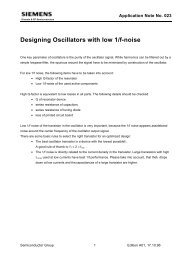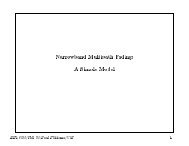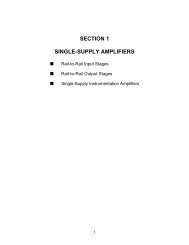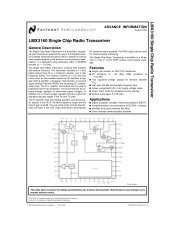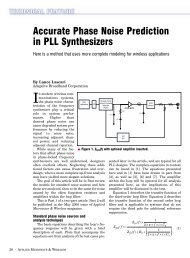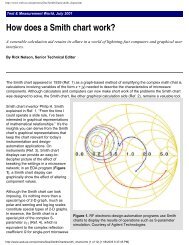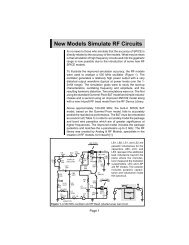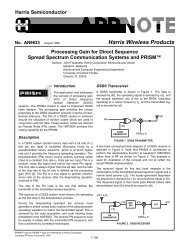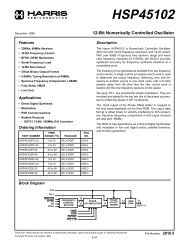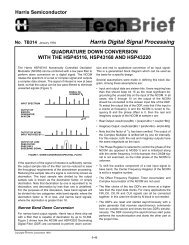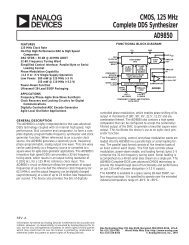Spread Spectrum - It's not just for breakfast anymore!
Spread Spectrum - It's not just for breakfast anymore!
Spread Spectrum - It's not just for breakfast anymore!
Create successful ePaper yourself
Turn your PDF publications into a flip-book with our unique Google optimized e-Paper software.
as possible. This spawns innovative and creativemethods to achieve this means. Then these meanstend to be passed back to the commercial sectorand benefit everybody.CDMA is <strong>not</strong> the exclusive province of directsequence systems; CDMA can also be used withfrequency hopping. TDMA is <strong>not</strong> the exclusiveprovince of narrowband systems; TDMA can alsobe used with direct sequence or frequency hopping.This isn't newIn the 1982 AMRAD letter (reprinted on page 4-11 of the ARRL SS Handbook), Hal Feinstein,WB3KDU, wrote,<strong>Spread</strong> spectrum has found its way into packetradio. <strong>Spread</strong> spectrum allows each node to havea unique code which acts as a hard address.A<strong>not</strong>her node in the system can send data to thatnode by encoding that data with the spreadspectrum address <strong>for</strong> the receiving node. Traffic<strong>for</strong> other nodes does <strong>not</strong> interfere because it wouldhave a different code. Among the reasons cited <strong>for</strong>employing spread spectrum <strong>for</strong> packet switchingare privacy, selected addressing, multipathprotection and band sharing. But it is interestingto <strong>not</strong>e that a load is taken off the contentioncollision approach because now a single frequencyis <strong>not</strong> in contention among the nodes wishing totransmit. The load is divided among the nodesaddresses, and each that is interested in sendingdata to a target node competes <strong>for</strong> that node only.This is the CDMA part of SS. This is one ofthose areas the FCC really wants hams toexperiment with. I think the paper has a lot ofinsight and it was even written over 13 years ago.PANSAT - A <strong>Spread</strong> <strong>Spectrum</strong> SatelliteThe Space Systems Academic Group (SSAG)at the Naval Postgraduate School (NPS) inMonterey, Cali<strong>for</strong>nia is actively designing andbuilding an amateur satellite named PANSAT (seefigure 4). PANSAT is the acronym <strong>for</strong> PetiteAmateur Navy Satellite. PANSAT is to become apacket digital store-and-<strong>for</strong>ward satellite varysimilar in capabilities as the existing PACSATs inorbit today. The tentative launch date of PANSATis late 1996, early 1997 as a Get Away Special(GAS) payload from the Space Shuttle.One big difference between today’s PACSATsand PANSAT is that PANSAT will use directsequence spread spectrum as the communicationsup and downlink.PANSAT is being designed from the ground upas an amateur satellite. The only military missionof PANSAT is as a training vehicle <strong>for</strong> theeducation of military officers in the Space SystemsCurricula by the design, fabrication, testing andoperation of a low-cost, low earth orbit (LEO),digital communications satellite. One of theengineering objectives of PANSAT includes theevaluation and per<strong>for</strong>mance of spread spectrumpacket radio communications using the Amateurcommunity as the user base.In order to facilitate the evaluation of spreadspectrum per<strong>for</strong>mance the SSAG is designing a lowcost spread spectrum modem and RF package to bepresented to the amateur community in a kit <strong>for</strong>m.The goal is to have the design of the spreadspectrum radio/modem available be<strong>for</strong>e the launchof PANSAT to allow Amateurs to build andbecome operational via terrestrial means. Thispresents an exciting exchange of technology andthe ability <strong>for</strong> the Amateur to build a low cost unitto experiment with. As the design anddevelopment progresses they will be presented inthe Amateur press.Future and SummaryNow is the time to begin experimenting withspread spectrum communications on a wider scale.Technology has advanced to the point whereAmateurs can af<strong>for</strong>d to build systems. Thebuilding blocks are available now in the <strong>for</strong>m ofApplication Specific Integrated Circuits. Therecent flood of consumer devices that employspread spectrum has also driven the price down. Inmany cases the Amateur can either use thesedevices under their present type acceptance ormodify them <strong>for</strong> Amateur operations. However,the Amateur should remain aware of the rules andregulations governing the particular device whether
it falls under Part 15 or Part 97 of the FCC Rulesand Regulations and remain within their guidelines.If the Amateur wishes to expand beyond thepresent Part 97 rules in bonafide experimentation,they are encouraged to join in the SpecialTemporary Authority.<strong>Spread</strong> spectrum systems exhibit uniquequalities that can<strong>not</strong> be obtained from conventionalnarrowband systems. There are many researchavenues exploring these unique qualities.Amateurs in their inherent pioneering nature canand will find new and novel applications <strong>for</strong> spreadspectrum communications that the commercialsector may <strong>not</strong> even think of. And due to the frugalpropensity of the Radio Amateur, they willcertainly find the least expensive way to implementit, thus driving down the cost.Amateurs should realize that there is plenty ofroom to explore spread spectrum techniques. Allthat remains now is to pick up a few good books onthe subject and warm up the soldering iron. And asyou progress upon this road less traveled, makesure you take <strong>not</strong>es along the way. Then shareyour discoveries with your fellow Amateur to helpall of us expand the horizon with this excitingmode of communications call spread spectrum. Itis no longer shrouded in secrecy and it’s <strong>not</strong> <strong>just</strong><strong>for</strong> <strong>breakfast</strong> <strong>anymore</strong>!WEB CrawlingHere are two WEB pages of interest. I'vestarted a general amateur radio SS page,http://www.tapr.org/ss.See also the PANSAT page athttp://www.sp.nps.navy.mil/pansat/pansat.htmlSelected BibliographyBooks -Extensive research oriented analysis -M.K. Simon, J. Omura, R. Scholtz, and K.Levitt, <strong>Spread</strong> <strong>Spectrum</strong> Communications Vol. I, II,III. Rockville, MD. Computer Science Press, 1985.Intermediate level -J.K. Holmes, Coherent <strong>Spread</strong> <strong>Spectrum</strong>Systems, New York, NY. Wiley Interscience, 1982.D.J. Torrieri, Principles of SecureCommunication Systems. Boston. Artech house,1985.Introductory to intermediate levels -G.R. Cooper and C.D. McGillem, ModernCommunications and <strong>Spread</strong> <strong>Spectrum</strong>, New York,McGraw-Hill, 1986.R.E. Ziemer and R.L. Peterson, DigitalCommunications and <strong>Spread</strong> <strong>Spectrum</strong> Systems,New York, Macmillan, 1985.R.E. Ziemer and R.L. Peterson,Introduction to Digital Communications, NewYork, Macmillan, 1985.Practical -R.C. Dixon, <strong>Spread</strong> <strong>Spectrum</strong> Systems,John-Wiley & Sons, 1984.Journals -There have been several special issues of IEEEpublications that are devoted to spread spectrumsystems. IEEE Transactions on Communications:August 1977 and May 1982. IEEE Journal ofSelected Areas in Communications: May 1990,June 1990, and May 1992.References(1) R.C. Dixon, <strong>Spread</strong> <strong>Spectrum</strong> Systems, John-Wiley & Sons, 1984, page 7.(2) K. Gilhousen, Qualcomm Inc., USENETnewsgroup discussion.
Power Spectral Density(PSD)Narrowband Wave<strong>for</strong>m<strong>Spread</strong> Wave<strong>for</strong>mNoise LevelFrequencyFigure 1. Comparison of a narrowband signal with a Direct Sequence <strong>Spread</strong> <strong>Spectrum</strong> signal. Thenarrowband signal is suppressed when transmitting spread spectrum.Power Spectral Density(PSD)Carrier Frequency “hops” from channel to channelFrequencyFigure 2. An example of Frequency Hopping <strong>Spread</strong> <strong>Spectrum</strong> signal.Data BurstTime0 Tf 2Tf 3Tf 4TfFigure 3. Time Hopping <strong>Spread</strong> <strong>Spectrum</strong>. Each burst consists of k bits of data and the exact time each burstis transmitted is determined by a PN sequence.
Solar Panels (17)Electrical Power Subsystem(EPS)Digital Control Subsystem(DCS A & B)Battery Box ACommunicationsSubsystemBattery Box BDipole Antennas (4)in turnstile configurationLaunch VehicleInterfaceCylindrical SupportFigure 4. A cut away view of PANSAT, a Direct Sequence <strong>Spread</strong> <strong>Spectrum</strong> satellite being designed and builtat the Naval Postgraduate School in Monterey, Cali<strong>for</strong>nia.



